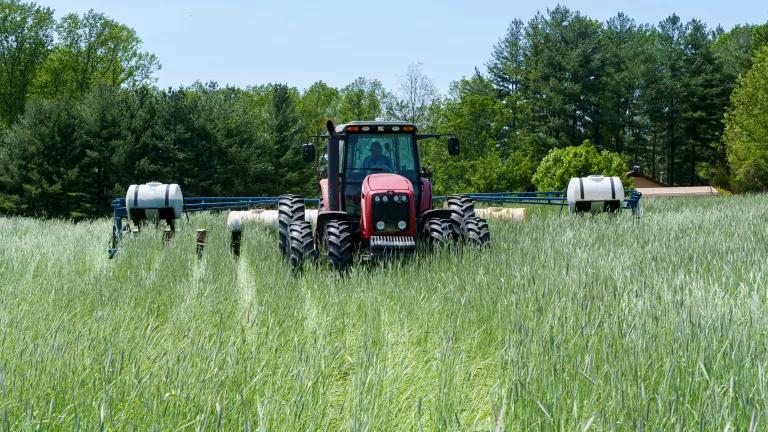What Is the Meat Industry Hiding About its Antibiotic Use?
While antibiotic use by U.S. chicken producers has dropped in recent years, use of antibiotics on cattle and pigs that are not sick remains rampant.
In a series of recent front-page stories, the New York Times has explored the U.S. livestock industries’ ongoing overuse of medically important antibiotics, the pharmaceutical industry’s aggressive marketing of these drugs for the same unnecessary uses, and how both relate to the public health crisis of rapidly rising antibiotic-resistant infections that are becoming harder, and sometimes impossible, to treat.
While antibiotic use by U.S. chicken producers has dropped significantly in recent years (as we explore in another blog), use of antibiotics on cattle and pigs that are not sick remains rampant. The latest article in the New York Times series highlights a fundamental problem in making headway against the overuse of these precious drugs—namely, a crippling culture of secrecy in the livestock sector.
Data and transparency are essential for protecting against the growing health threat posed by drug-resistant infections, an epidemic fueled in large part by antibiotics overuse, including in livestock. New estimates put the death toll from antibiotic-resistant infections in the U.S. at over 160,000 deaths a year, which would make it the third-leading cause of death in the U.S. (If you need a quick refresher on why antibiotic use in agriculture matters, check out this fact sheet.)
For example, the Times article describes how the pork industry resisted sharing information and even refused to allow government biologists on site to do testing even during an investigation to track down the source of a deadly outbreak of antibiotic resistant Salmonella. Another article in the series points out that industry (both pharma and big meat) has attacked calculations of antibiotic use by public interest groups, “while simultaneously lobbying to block legislation requiring more disclosure of antibiotic use.” We have seen that dynamic play out in our own experiences advocating for legislation to improve data collection on livestock antibiotic use practices in Maryland and California and in the city of San Francisco.
Information about on-farm antibiotic use is fundamental for understanding the where, what, when, who, and why of the antibiotic resistance problem, and for targeting resources and solutions to making sure antibiotics are only used appropriately and when absolutely necessary. The fact that we currently have no better data than overall national sales of antibiotics (albeit with species-level estimates) leaves scientists, public health experts and policymakers at a disadvantage in addressing the problem of antibiotic resistance. We need better data for better results. Better antibiotic use data would also allow us to evaluate the actual progress of companies and governments in achieving more responsible antibiotic use.
For instance, the federal Food and Drug Administration’s (FDA’s) recent requirement via Guidance 213 to get a veterinarian’s approval before using antibiotics (yes, antibiotic use without veterinarian’s orders was allowed until very recently) has helped reduce the sale of livestock antibiotics in the last couple of years for the first time since 2009. That same Guidance also banned the use of antibiotics to fatten up animals. BUT it continued to allow essentially the same use of antibiotics for the purposes of “preventing” infection in animals living in stressful and crowded conditions typical of industrial farms. How much of the reduction is the result of greater veterinarian involvement? How much of the reduction is the result of the ban on using antibiotics to increase animal weight? How much of the antibiotics are still being used in a similar way for “prevention”? These are the kinds of questions we can’t know the answers to without better data collection on antibiotic use.
Other countries with large and thriving meat industries, such as Denmark and the Netherlands, long ago started collecting on-farm antibiotic use data and using it to target and reduce their overuse of antibiotics. There’s no excuse for not doing the same in the U.S. The future of medicine may depend on it, since livestock production still accounts for 64% of all U.S. sales of the antibiotics important to human medicine.
Recent reports indicate that prescriptions for feed use of antibiotics (known as veterinary feed directives or VFDs) are electronically available, and information about antibiotic use should be trackable through technology like RFID tags. However, this information is still not being collected—in large part because any kind of data transparency is steadfastly opposed by the industry.
A strong law to collect data on antibiotic use has passed in Maryland and a more modest one in California, but that leaves out most of the country. San Francisco has embarked on a promising effort to collect information on antibiotic use for brands sold in San Francisco—it has the potential to inform consumers and drive market changes, but the project is still in its early stages. All of this emphasizes the need for national data on antibiotic use in meat production.
The livestock industry and the federal government need to stop hiding critical information from the public. Consumers are increasingly demanding transparency about the food they eat, including meat. And these detailed antibiotic use data are key to addressing a health threat that has profound implications for public health. In Netherlands, the industry worked with the government to develop a system where the industry collects the data and shares it with the government to provide a degree of confidentiality. In the UK, leading retailers are tracking the antibiotic use in their supply chain. We know this is possible and it is essential. The culture of secrecy has to end if we are to preserve the efficacy of these essential medicines.
This blog provides general information, not legal advice. If you need legal help, please consult a lawyer in your state.




